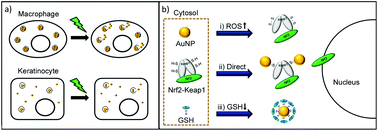The bright side of plasmonic gold nanoparticles; activation of Nrf2, the cellular protective pathway
Abstract
Plasmonic gold nanoparticles (AuNPs) are widely investigated for cancer therapy, due to their ability to strongly absorb light and convert it to heat and thus selectively destroy tumor cells. In this study we shed light on a new aspect of AuNPs and their plasmonic excitation, wherein they can provide anti-oxidant and anti-inflammatory protection by stimulating the cellular protective Nrf2 pathway. Our study was carried out on cells of the immune system, macrophages, and on skin cells, keratinocytes. A different response to AuNPs was noted in the two types of cells, explained by their distinct uptake profiles. In keratinocytes, the exposure to AuNPs, even at low concentrations, was sufficient to activate the Nrf2 pathway, without any irradiation, due to the presence of free AuNPs inside the cytosol. In contrast, in macrophages, the plasmonic excitation of the AuNPs by a low, non-lethal irradiation dose was required for their release from the constraining vesicles. The mechanism by which AuNPs activate the Nrf2 pathway was studied. Direct and indirect activation were suggested, based on the inherent ability of the AuNPs to react with thiol groups and to generate reactive oxygen species, in particular, under plasmonic excitation. The ability of AuNPs to directly activate the Nrf2 pathway renders them good candidates for treatment of disorders in which the up-regulation of Nrf2 is beneficial, specifically for topical treatment of inflammatory skin diseases.


 Please wait while we load your content...
Please wait while we load your content...